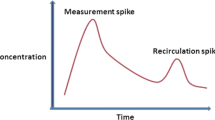Abstract
Objectives
Bioreactance, the analysis of intrabeat variations in phase of a transthoracic voltage in response to an applied high frequency transthoracic current, was recently introduced for noninvasive cardiac output measurement (NICOM). We evaluated NICOM compared to thermo- dilution (TD) in several clinical settings.
Methods
111 patients with a clinical indication for TD cardiac output (CO) measurement were recruited at five centers, including patients in cardiac catheterization laboratories, cardiac care units and intensive care units. CO measurements were made simulta- neously with TD and the bioreactance method and compared by regression analysis.
Results
For studies in the intensive care units, TD-based CO and NICOM were highly correlated (r = 0.78, P < 0.0001) and did not differ significantly from each other (P = 0.55). Results in the cardiac catheterization laboratory were similar (r = 0.71, P < 0.001; P = 0.28 NICOM versus TD). In subsets of patients, NICOM was shown to be better corre- lated with TD-CO than CO obtained with the Fick method or with standard bioimpedance-based measurements of CO.
Conclusions
On average, compared to TD, bioreactance- based NICOM has acceptable accuracy in challenging clinical environments. Availability of such a tool may allow clinicians to have information about CO in patients where this information is not currently available to help diagnosis and guide therapy.
Similar content being viewed by others
References
Boldt J, Kling D, Thiel A, Hempelmann G. Non-invasive versus invasive cardiovascular monitoring. Determination of stroke volume and pulmonary hydration using a new bioimpedance monitor. Anaesthesist 1988; 37: 218–223.
Rubini A, Del MD, Catena V, et al. Cardiac output measurement by the thermodilution method: an in vitro test of accuracy of three commercially available automatic cardiac output computers. Intensive Care Med 1995; 21: 154–158.
Zollner C, Polasek J, Kilger E, et al. Evaluation of a new continuous thermodilution cardiac output monitor in cardiac surgical patients: a prospective criterion standard study. Crit Care Med 1999; 27: 293–298.
Kubicek WG, Karnegis JN, Patterson RP, Witsoe DA, Mattson RH. Development and evaluation of an impedance cardiac output system. Aerosp Med 1966; 37: 1208–1212.
Engoren M, Barbee D. Comparison of cardiac output determined by bioimpedance, thermodilution, and the Fick method. Am J Crit Care 2005; 14: 40–45.
Leslie SJ, McKee S, Newby DE, Webb DJ, Denvir MA. Non-invasive measurement of cardiac output in patients with chronic heart failure. Blood Press Monit 2004; 9: 277–280.
Keren H, Burkhoff D, Squara P. Evaluation of a noninvasive continuous cardiac output monitoring system based on thoracic bioreactance. Am J Physiol Heart Circ Physiol 2007; 293: H583–H589.
Squara P, Denjean D, Estagnasie P, Brusset A, Dib JC, Dubois C. Noninvasive cardiac output monitoring (NICOM): a clinical validation. Intensive Care Med 2007; 33: 1191–1194.
Squara P, Marque S, Cariou A, Chiche J. Non invasive cardiac output monitoring (NICOM) compared to minimally invasive monitoring (VIGILEO) (abstr). Anesthesiology 2007; 107: A1527.
Frezza EE, Mezghebe H. Indications and complications of arterial catheter use in surgical or medical intensive care units: analysis of 4932 patients. Am Surg 1998; 64: 127–131.
Kac G, Durain E, Amrein C, Herisson E, Fiemeyer A, Buu-Hoi A. Colonization and infection of pulmonary artery catheter in cardiac surgery patients: epidemiology and multivariate analysis of risk factors. Crit Care Med 2001; 29: 971–975.
Gratz I, Kraidin J, Jacobi AG, deCastro NG, Spagna P, Larijani GE. Continuous noninvasive cardiac output as estimated from the pulse contour curve. J Clin Monit 1992; 8: 20–27.
Combes A, Berneau JB, Luyt CE, Trouillet JL. Estimation of left ventricular systolic function by single transpulmonary thermodilution. Intensive Care Med 2004; 30: 1377–1383.
Su NY, Huang CJ, Tsai P, Hsu YW, Hung YC, Cheng CR. Cardiac output measurement during cardiac surgery: esophageal Doppler versus pulmonary artery catheter. Acta Anaesthesiol Sin 2002; 40: 127–133.
Dark PM, Singer M. The validity of trans-esophageal Doppler ultrasonography as a measure of cardiac output in critically ill adults. Intensive Care Med 2004; 30: 2060–2066.
Rocco M, Spadetta G, Morelli A, et al. A comparative evaluation of thermodilution and partial CO2 rebreathing techniques for cardiac output assessment in critically ill patients during assisted ventilation. Intensive Care Med 2004; 30: 82–87.
Bland JM, Altman DG. Statistical methods for assessing agreement between two methods of clinical measurement. Lancet 1986; 1: 307–310.
Medin DL, Brown DT, Wesley R, Cunnion RE, Ognibene FP. Validation of continuous thermodilution cardiac output in critically ill patients with analysis of systematic errors. J Crit Care 1998; 13: 184–189.
Myers J, Gujja P, Neelagaru S, Burkhoff D. Cardiac output and cardiopulmonary responses to exercise in heart failure: application of a new bio-reactance device. J Card Fail 2007; 13: 629–636.
Ziegeler S, Grundmann U, Fuerst O, Raddatz A, Kreuer S. Hemodynamic response to exercise as measured by the solar IKG impedance cardiography module and correlation with metabolic variables. J Clin Monit Comput 2007; 21: 13–20.
Brown CV, Martin MJ, Shoemaker WC, et al. The effect of obesity on bioimpedance cardiac index. Am J Surg 2005; 189: 547–550.
Author information
Authors and Affiliations
Corresponding author
Additional information
Raval NY, Squara P, Cleman M, Yalamanchili K, Winklmaier M, Burkhoff D. Multicenter evaluation of noninvasive cardiac output measurement by bioreactance technique.
Rights and permissions
About this article
Cite this article
Raval, N.Y., Squara, P., Cleman, M. et al. Multicenter Evaluation of Noninvasive Cardiac Output Measurement by Bioreactance Technique. J Clin Monit Comput 22, 113–119 (2008). https://doi.org/10.1007/s10877-008-9112-5
Received:
Accepted:
Published:
Issue Date:
DOI: https://doi.org/10.1007/s10877-008-9112-5




